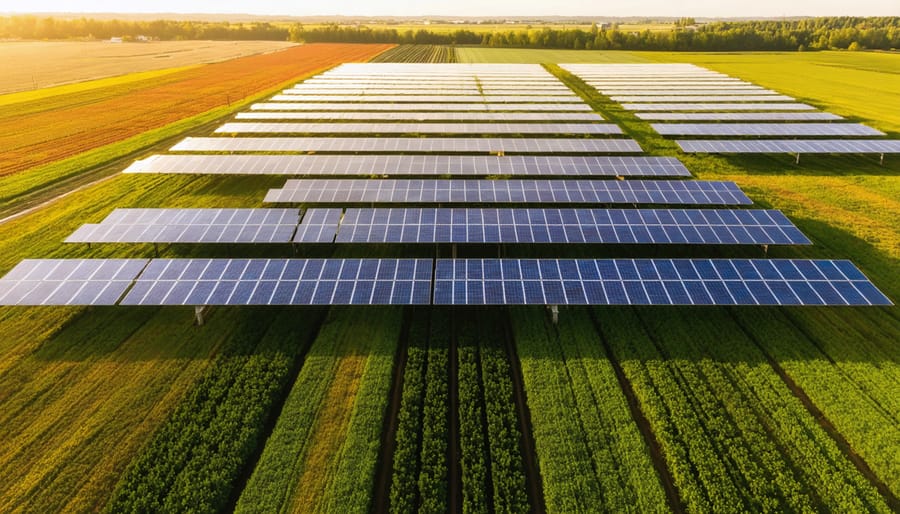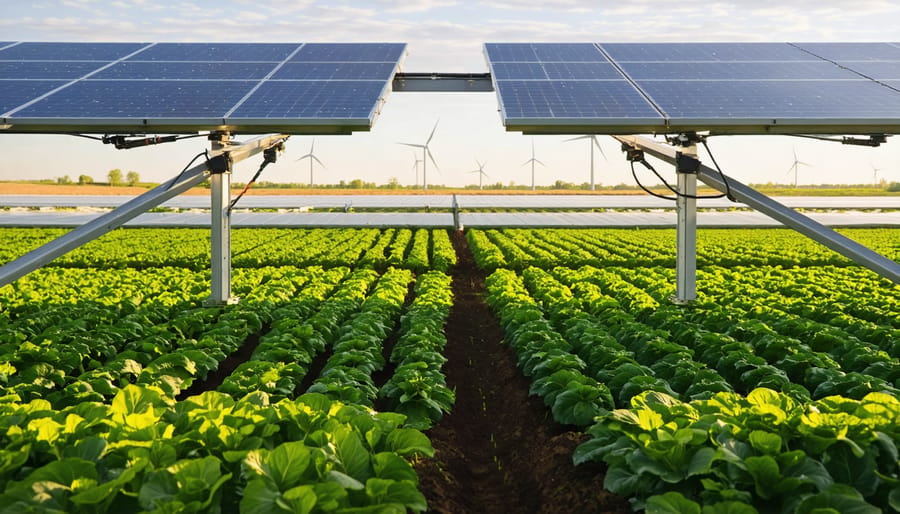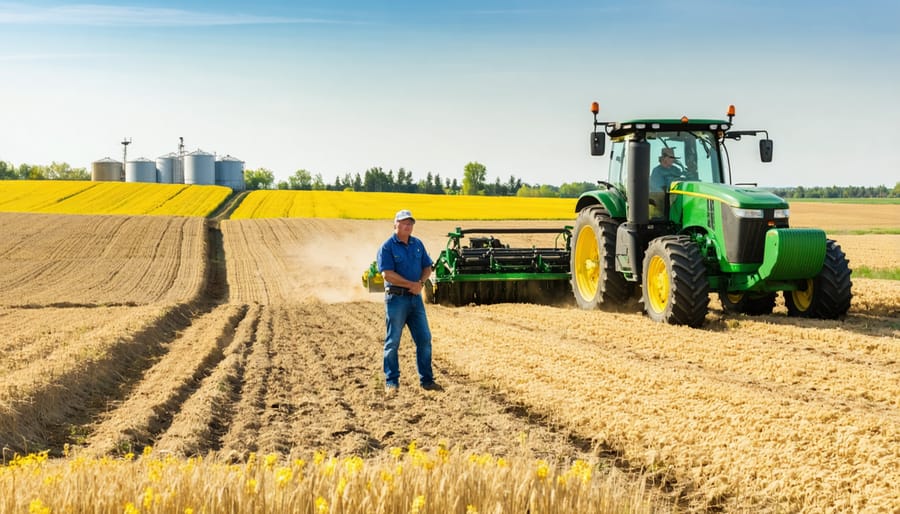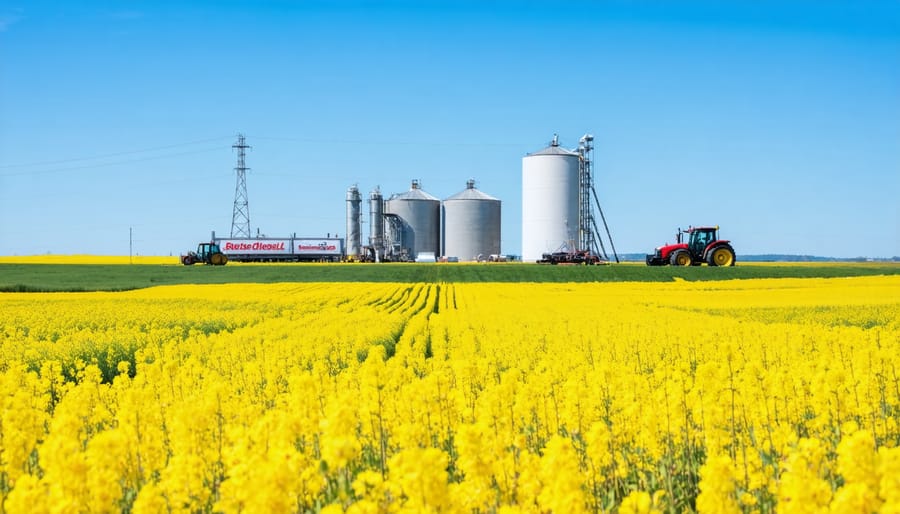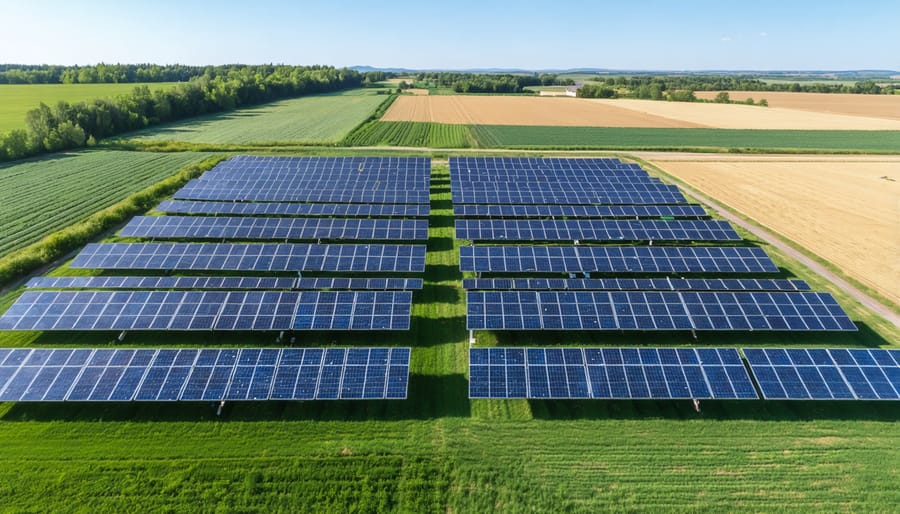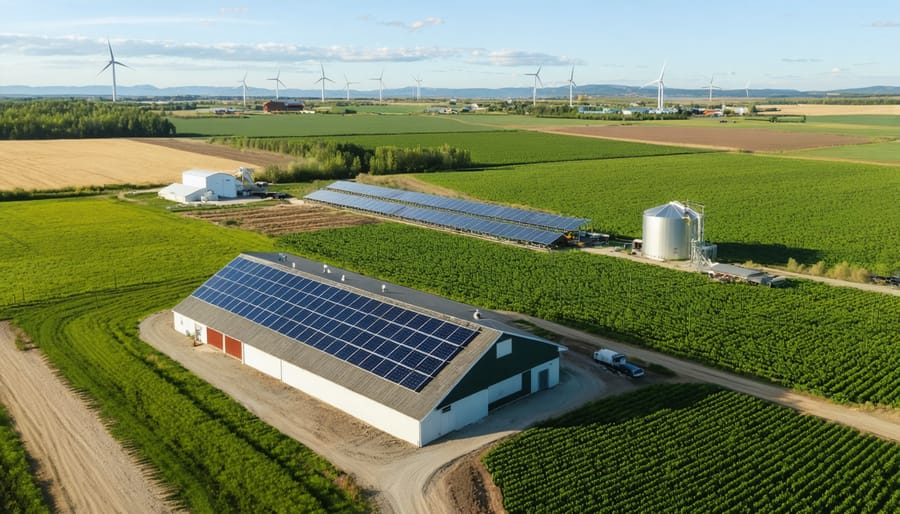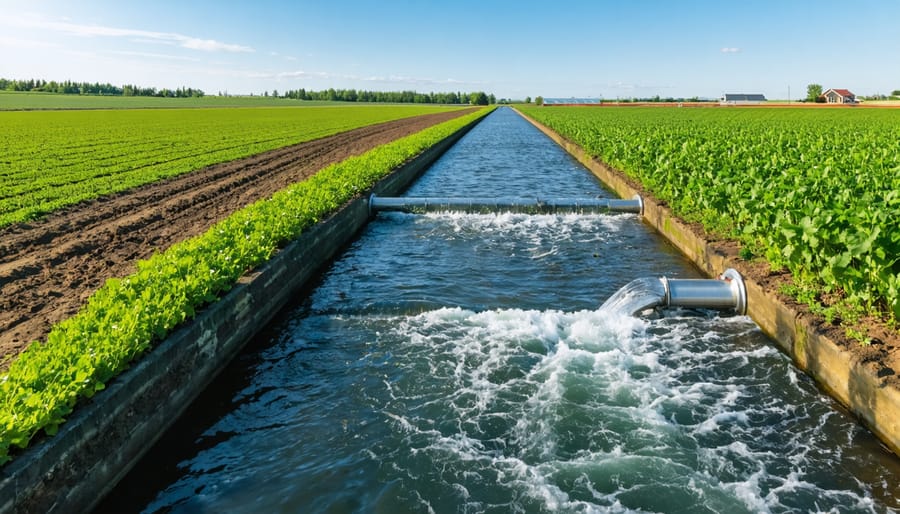Imagine harvesting both sunlight and crops from the same patch of Alberta soil. Agrivoltaics is revolutionizing Canadian agriculture by combining solar energy generation with traditional farming practices, offering farmers a powerful solution to rising energy costs and climate challenges. Already proving successful in Southern Alberta’s sun-rich environment, this innovative farming approach increases land-use efficiency by up to 70% while providing crucial shade for heat-sensitive crops and reducing water consumption by 30%. For forward-thinking Canadian farmers, agrivoltaics represents more than just an agricultural trend—it’s a practical pathway to sustainable farm income through dual revenue streams: crop yields and clean energy production. As global food and energy demands intensify, Alberta’s agricultural community stands uniquely positioned to lead North America’s transition to this groundbreaking farming method.
What Makes Agrivoltaics Work in Alberta
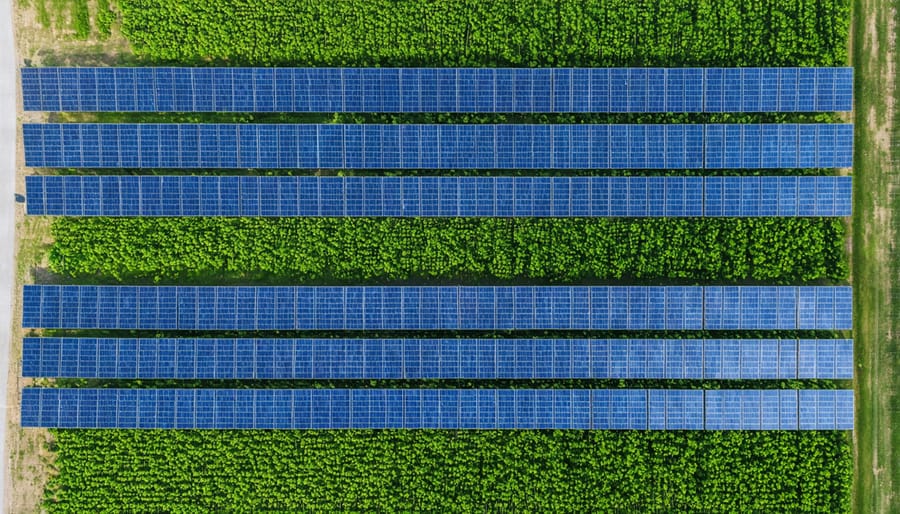
Climate Benefits
Solar panels create unique microclimates that can significantly benefit crop growth in Alberta’s challenging weather conditions. During our harsh winters, the panels act as protective barriers against frost and extreme cold, while in summer, they provide essential shade that reduces water evaporation and protects sensitive plants from intense sunlight.
Research conducted at Olds College Smart Farm shows that the partial shade from solar arrays can lower soil temperatures by 3-5°C during peak summer hours, creating ideal growing conditions for many crops. This temperature regulation is particularly valuable during Alberta’s hot, dry spells, helping to conserve soil moisture and reduce plant stress.
The panels also offer protection from damaging hail events, which have become increasingly common across the province. Local farmers report that crops grown under solar installations show better resilience during extreme weather events. The modified microclimate beneath the panels extends the growing season by approximately 2-3 weeks, allowing for greater crop diversity and improved yields.
Additionally, the vertical air movement created between panels helps maintain optimal humidity levels and reduces the risk of fungal diseases, particularly in moisture-sensitive crops like leafy greens and berries.
Land Optimization
Agrivoltaic systems excel at maximizing land use efficiency by combining agricultural production with solar energy generation on the same plot. For Alberta farmers dealing with increasing land costs and variable weather patterns, this dual-use approach can boost land productivity by up to 60%. A typical 10-hectare agrivoltaic installation can maintain roughly 80% of the original farming capacity while generating enough power for 1,000 homes.
Our local experience shows that careful panel spacing and elevation allows ample room for machinery operation while creating beneficial microclimates. During summer heat waves, crops grown under panels typically require 20-30% less irrigation water. In the Prairie region, these systems have proven particularly effective for crops like leafy greens, berries, and certain grain varieties that benefit from partial shade.
The key to successful land optimization lies in strategic design. Working with local agricultural extension offices, farmers can determine optimal panel heights (typically 3-4 metres) and spacing (6-8 metres between rows) to accommodate both farming equipment and crop requirements. This thoughtful integration ensures neither energy production nor farming activities are compromised, making the most of every square metre of farmland.
Crop Selection and Panel Configuration
Best Performing Crops
Research conducted across Alberta’s agrivoltaic installations has identified several crops that perform exceptionally well under partial shade conditions. Understanding optimal crop selection is crucial for successful agrivoltaic farming in our climate.
Leafy greens, particularly spinach, kale, and lettuce, have shown impressive yields under solar panels, with some farmers reporting 15-20% increased production compared to conventional growing methods. These crops benefit from the reduced heat stress and improved soil moisture retention beneath the panels.
Root vegetables like potatoes and carrots have also demonstrated strong performance, though careful spacing of solar arrays is essential to ensure adequate light penetration. Field trials in Southern Alberta have shown successful yields with these crops receiving 70-80% of full sunlight.
Certain berry crops, including saskatoons and haskap berries, adapt well to partial shade conditions and can create valuable secondary income streams. These native species are particularly resilient in our climate and require minimal additional irrigation under agrivoltaic systems.
Cool-season crops such as peas and broad beans have shown promising results, especially when planted early in the season. The modified microclimate under solar panels can extend their growing season by protecting against late spring frosts and early fall freezes.
For Alberta farmers, these crop choices offer practical options that maximize both energy and agricultural production while maintaining sustainable farming practices.
Panel Setup Guidelines
For optimal agrivoltaic system performance in Alberta’s climate, solar panels should be installed at a 30-35 degree tilt, facing south to maximize sunlight capture. The ideal panel height ranges from 3 to 4 metres above ground level, allowing for adequate crop growth and easy farm equipment access underneath.
Spacing between panel rows is crucial and typically requires 6 to 8 metres to prevent excessive shading. This configuration enables about 60-70% of the field to receive direct sunlight throughout the day, creating a beneficial microclimate for crops that prefer partial shade, such as leafy greens and root vegetables.
In our Alberta installations, we’ve found that bifacial solar panels perform exceptionally well, as they can capture reflected light from snow cover during winter months. These panels should be arranged in east-west oriented rows to optimize both energy generation and crop production.
For structural stability in our prairie winds, support poles should be secured at least 2 metres deep with concrete foundations. We recommend using galvanized steel frameworks that can withstand our extreme weather conditions while maintaining a minimum lifespan of 25 years.
When planning your layout, consider your specific crop rotation needs and existing irrigation systems. Many Alberta farmers have successfully integrated pivot irrigation systems by adjusting panel heights and spacing accordingly. Remember to account for snow accumulation and include adequate drainage channels between panel rows to manage spring melt.
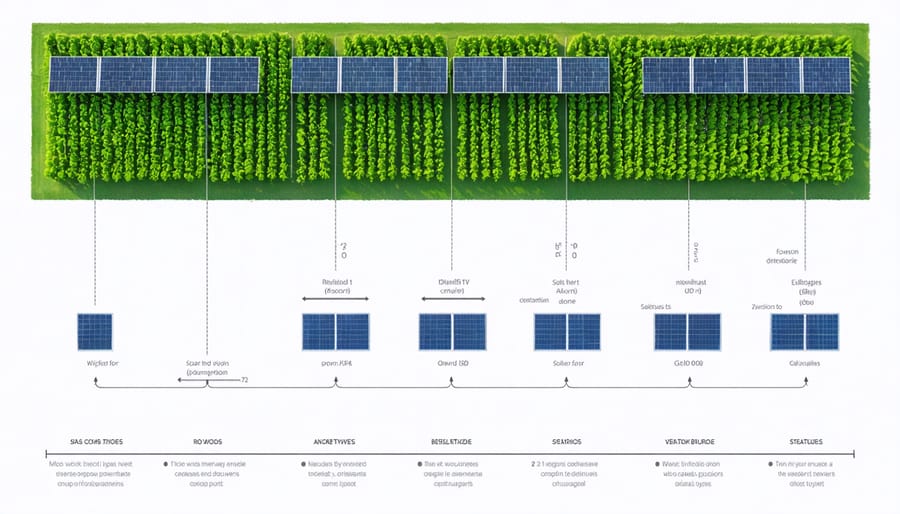
Economic Impact
Investment and Returns
Initial investment in agrivoltaics typically ranges from $35,000 to $75,000 per hectare, depending on system design and local conditions. While this may seem substantial, Alberta farmers can access various governmental incentives and grants, including the Canadian Agricultural Clean Technology Program, which can offset up to 50% of installation costs.
The dual-income potential makes agrivoltaics particularly attractive, with solar power investment benefits providing steady revenue through power generation while maintaining agricultural productivity. Most systems generate between 350-500 kWh per square metre annually, translating to approximately $15,000-$25,000 in energy revenue per hectare.
Crop yields under agrivoltaic systems typically maintain 60-95% of conventional production levels, with some shade-tolerant crops showing improved yields. The combined income from energy generation and crop production often results in a return on investment within 5-8 years.
Maintenance costs average $1,200-$2,000 per hectare annually, including panel cleaning, system monitoring, and routine inspections. Insurance providers are increasingly offering specialized coverage for agrivoltaic systems, with annual premiums ranging from $800-$1,500 per hectare, depending on coverage options and system value.
Available Grants and Incentives
Several financial support programs are available to Canadian farmers interested in implementing agrivoltaics systems. At the federal level, the Agricultural Clean Technology Program offers funding of up to $2 million for projects that combine renewable energy with agricultural innovation. The program specifically includes solar installations integrated with active farming operations.
In Alberta, the Agriculture and Forestry Grant Program provides matching funds of up to $100,000 for sustainable farming initiatives. The Rural Energy Systems Acceleration (RESA) program offers additional support specifically for renewable energy projects in agricultural settings, covering up to 30% of eligible costs.
Farmers can also access the Canadian Agricultural Partnership (CAP) funding, which provides cost-sharing opportunities for environmental sustainability projects. The Environmental Stewardship and Climate Change Producer Program, specific to Alberta, offers grants ranging from $15,000 to $50,000 for projects that enhance environmental sustainability while maintaining agricultural productivity.
Local rural municipalities often provide property tax incentives for agricultural properties implementing renewable energy solutions. Additionally, the Alberta Utilities Commission offers streamlined approval processes and reduced fees for agricultural solar installations under 5MW capacity.
To access these programs, farmers should consult with their local agricultural service board or renewable energy advisory services for application assistance and current funding availability.
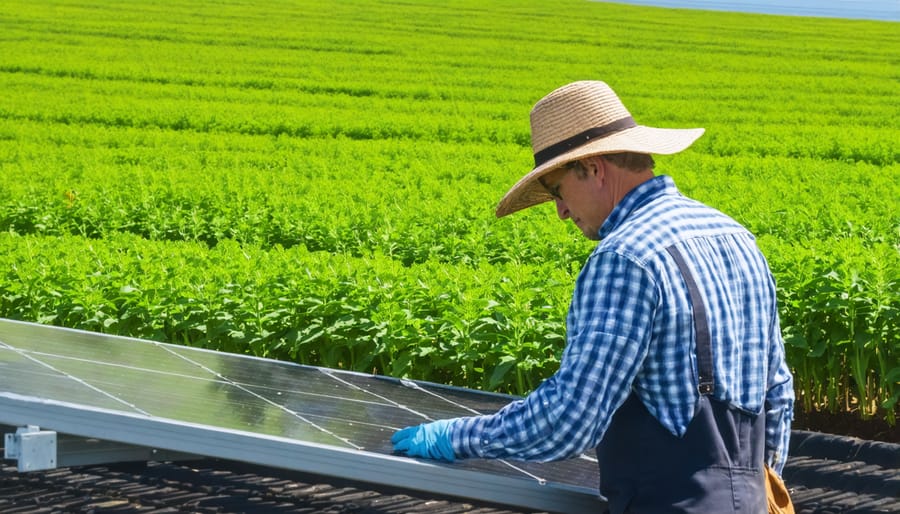
Real Success Stories
In southern Alberta, the Schneider family farm stands as a shining example of successful agrivoltaics implementation. Since 2019, their 40-hectare operation near Lethbridge has combined solar panels with traditional crop rotation, resulting in a 15% increase in overall farm revenue. The Schneiders grow drought-resistant crops like winter wheat and beans under elevated solar arrays, which provide partial shade and help retain soil moisture during hot summer months.
Another inspiring case comes from the Medicine Hat region, where Sarah Thompson’s greenhouse operation demonstrates year-round success with agrivoltaics. Her 2-hectare facility uses bifacial solar panels mounted 4 metres above specialized greenhouse structures, allowing for optimal light distribution to crops below. Thompson reports a 30% reduction in energy costs and a 20% increase in tomato yield during peak summer months due to the modified microclimate created by the panels.
The Morrison Valley Farms collective, located near Red Deer, showcases how multiple farmers can benefit from shared agrivoltaic infrastructure. Their 100-hectare collaborative project, established in 2020, integrates solar panels with grazing pastures for sheep. The initiative has reduced irrigation needs by 25% while maintaining consistent forage production. The collective now generates enough electricity to power 200 local homes while supporting sustainable livestock operations.
These success stories share common elements: careful planning, community support, and partnership with experienced solar installers. The Schneiders worked closely with local agricultural extension services to optimize panel placement. Thompson collaborated with greenhouse specialists to design her custom system. The Morrison Valley collective partnered with regional renewable energy experts to ensure proper integration with existing farm operations.
Real-world data from these installations shows that initial investments, while significant, typically see returns within 6-8 years through combined energy savings and improved crop yields. The systems have proved particularly resilient during extreme weather events, with the partial shade from panels helping to protect crops during the record-breaking heat waves of recent summers.
These Alberta pioneers in agrivoltaics continue to share their experiences through farm tours and mentorship programs, helping other farmers understand the practical aspects of implementation and maintenance. Their success demonstrates that agrivoltaics is not just a concept but a viable farming strategy for Alberta’s agricultural future.
Getting Started
Starting your agrivoltaic farming journey requires careful planning and a systematic approach. First, assess your land’s solar potential by conducting a site evaluation. Consider factors like sun exposure, terrain, and existing infrastructure. Most successful Alberta farmers begin with a 1-2 hectare pilot project before scaling up.
Next, connect with local agricultural extension offices and solar installation experts. The Alberta Solar Society and municipal agricultural offices can provide valuable guidance on permits, regulations, and available grants. Many regions offer incentives for renewable energy integration in agriculture.
Create a detailed farm plan that outlines:
– Crop selection (shade-tolerant varieties work best)
– Solar panel configuration (typical height 3-4 metres)
– Irrigation system modifications
– Equipment access requirements
– Power storage and distribution strategy
Start small with test plots to understand how different crops respond to partial shade. Popular starter crops include leafy greens, berries, and certain root vegetables. Document growth patterns, yield changes, and microclimatic conditions throughout the growing season.
Partner with experienced agrivoltaic farmers through mentorship programs. The Prairie Agricultural Machinery Institute offers hands-on workshops where you can learn about equipment modifications and maintenance requirements. Consider joining local farming cooperatives that support sustainable agriculture initiatives.
Remember to secure financing early. Agricultural lenders are increasingly familiar with agrivoltaic projects, and several government programs offer cost-sharing opportunities. Many successful operations start with a phased implementation approach, allowing for adjustments based on initial results while managing upfront costs effectively.
Agrivoltaics represents a groundbreaking opportunity for Canadian farmers to maximize their land use while contributing to sustainable energy production. By combining solar energy generation with traditional farming practices, producers can potentially increase their income by 30-60% while maintaining crop yields. The benefits extend beyond economics – from water conservation to improved crop resilience in our changing climate. As Alberta continues to lead in agricultural innovation, now is the time for farmers to explore this dual-land-use approach. We encourage you to connect with local agricultural extension offices, attend information sessions, and join the growing community of forward-thinking producers already implementing agrivoltaic systems. Together, we can build a more sustainable and profitable future for Canadian agriculture. Take the first step by reaching out to solar installers who specialize in agricultural applications and discussing possibilities for your operation.

